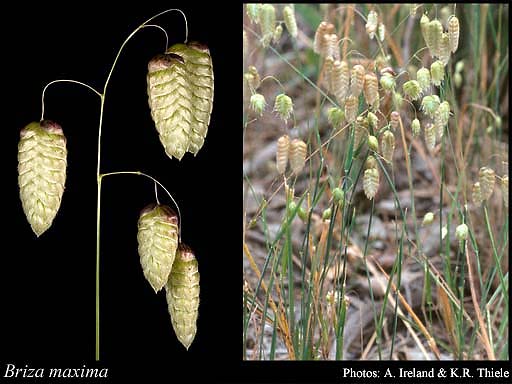- Reference
- Sp.Pl. [Linnaeus] 1:70 (1753)
- Conservation Code
- Not threatened
- Naturalised Status
- Alien to Western Australia
- Name Status
- Current
Tufted, glabrous annual, grass-like or herb, 0.2-0.6 m high. Fl. green-purple, Sep to Oct. Sand, loam, clay.







Distribution
- IBRA Regions
- Avon Wheatbelt, Esperance Plains, Geraldton Sandplains, Jarrah Forest, Mallee, Swan Coastal Plain, Warren.
- IBRA Subregions
- Dandaragan Plateau, Fitzgerald, Geraldton Hills, Katanning, Lesueur Sandplain, Merredin, Northern Jarrah Forest, Perth, Recherche, Southern Jarrah Forest, Warren, Western Mallee.
- IMCRA Regions
- Central West Coast, WA South Coast.
- Local Government Areas (LGAs)
- Albany, Armadale, Augusta Margaret River, Beverley, Boyup Brook, Bridgetown-Greenbushes, Broomehill-Tambellup, Bruce Rock, Busselton, Canning, Capel, Chapman Valley, Chittering, Cockburn, Collie, Coorow, Cranbrook, Cuballing, Cunderdin, Dalwallinu, Dandaragan, Dardanup, Denmark, Donnybrook-Balingup, Dowerin, Esperance, Gingin, Goomalling, Gosnells, Greater Geraldton, Jerramungup, Joondalup, Kalamunda, Kellerberrin, Kondinin, Kulin, Kwinana, Mandurah, Manjimup, Melville, Merredin, Mundaring, Murray, Narrogin, Nedlands, Northam, Northampton, Perenjori, Perth, Pingelly, Plantagenet, Ravensthorpe, Rockingham, Serpentine-Jarrahdale, Stirling, Swan, Toodyay, Trayning, Victoria Plains, Wagin, Wandering, Wanneroo, Waroona, West Arthur, Wickepin, Williams, Wongan-Ballidu, Woodanilling, Wyalkatchem, York.
Management Notes (for the Swan NRM Region)
Alternative Names. Big quaking grass, great quaking grass.
General Biology. Growth form. Grass. Life form. Annual, caespitose. Reproduction. Seed. Dispersal. Water, wind, mammals, slashing. Photosynthetic Pathway. C3. Seedbank persistence. Medium, up to 3 years. Fire response. Fire promotes germination of soil-stored seed.
Notes. Cultivated and naturalised in the British Isles, New Zealand, United States, Central and South America and Hawaii. Germination of seed is not affected by light and increases after 10 days to 6 months of after-ripening.
Additional information. Origin. North Africa, temperate western Asia, southeastern and southwestern Europe. History of use/introduction. Seed contaminant in crops, ornamental.
Suggested method of management and control. Prevent seed set. Hand pull or spray at 3-5 leaf stage with Fusilade® Forte at 16 ml/10 L or 800 ml/ha (based on 500 L water/ha) + wetting agent or for generic fluazifop-p (212g/L active ingredient) 10ml/10L or 500ml/ha + wetting agent. Repeat treatment for 2 - 3 years. Read the manufacturers' labels and material safety data sheets before using herbicides. For further information consult the Australian Pesticides and Veterinary Medicines Authority to determine the status of permits for your situation or state.
Management Calendar
| Calendar Type | Jan | Feb | Mar | Apr | May | Jun | Jul | Aug | Sep | Oct | Nov | Dec | Comments |
|---|---|---|---|---|---|---|---|---|---|---|---|---|---|
| Active Growth | O | Y | Y | Y | Y | ||||||||
| Germination | Y | Y | Y | Y | |||||||||
| Flowering | Y | Y | Y | ||||||||||
| Fruiting | Y | Y | Y | ||||||||||
| Optimum Treatment | O | Y | Y | O |
Legend: Y = Yes, regularly, O = Occasionally, U = Uncertain, referred by others but not confirmed.
References
- Blood, K. (2001) Environmental weeds: a field guide for SE Australia. C.H. Jerram and Associates, Melbourne.
- Brown, K. & Brooks, K. (2002) Bushland Weeds: A Practical Guide to their Management. Environmental Weeds Action Network, Greenwood.
- Hussey, B.M.J., Keighery, G.J., Dodd, J., Lloyd, S.G. & Cousens, R.D. (2007) Western Weeds. A guide to the weeds of Western Australia. 2nd Edition. The Plant Protection Society of Western Australia, Victoria Park.
- Lombardi, T., Fochetti, T. & Onnis, A. (1998) Germination of Briza maxima L. seeds: Effects of temperature, light, salinity and seed harvesting time. Seed Science & Technology, 26 (2): 463-470.
- Lunt, I.D. (1990) Impact of an autumn fire on a long-grazed Themeda triandra (Kangaroo Grass) grassland: implications for management of invaded, remnant vegetation. Victorian Naturalist, 107 (2): 45-51.
- McMahon, A.R.G. (1991) Control of annual grasses with particular reference to Briza maxima. Plant Protection Quarterly, 6 (3): 129.
- Milberg, P. & Lamont, B.B. (1995) Fire enhances weed invasion of roadside vegetation in southwestern Australia. Biological Conservation, 73 (1): 45-49.
- Moore, C.B. & Moore, J.H. (2002) Herbiguide, the pesticide expert on a disk. Herbiguide, PO Box 44 Albany, Western Australia, 6330.
- Moore, J.H. & Wheeler, J. (2008) Southern weeds and their control. DAFWA Bulletin 4744.
- Muyt, A. (2001) Bush invaders of South-East Australia: A guide to the identification and control of environmental weeds found in South-East Australia. R.G. & F.J. Richardson, Melbourne.
- Shire of Yarra Ranges (2002) Environmental Weeds in the Shire of Yarra Ranges. URL: http://www.yarraranges.vic.gov.au/Files/Environmental_Weeds_in_Yarra_Ranges_brochure.pdf.
- Tucker, P. (1997) Bushland weeds in South Australia. Trees for Life.
- USDA, ARS, National Genetic Resources Program (2009) Germplasm Resources Information Network - (GRIN). National Germplasm Resources Laboratory, Beltsville, Maryland. URL: https://npgsweb.ars-grin.gov/gringlobal/taxon/taxonomysimple.aspx - Accessed October 2009.